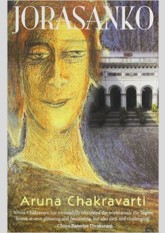Jorasanko
High politics, romance, tragedy and the little things that make up a family life in Jorasanko, Kolkata - the family home of the Tagores. Jorasanko was right at the hub of the Bengal Renaissance, with the family at the forefront of the movement, and its women playing a pivotal role. In a sprawling novel that spans a unique phase in the history of Bengal and India, Aruna Chakravarti provides a fascinating account of how the Tagore women influenced and were int urn influenced by their illustrious male counterparts, the times they lived in and the family they belonged to. She paints memorable portraits of women like Digambari, Dwarkanath's strong-willed wife who refuses to accept her husband's dalliance with alcohol and Western ways; Sarada Sundari, the obese, indolent but devoted wife of Debendranath, who is appalled to see the old world order slipping by; the indomitable Jogmaya, who takes on Debendranath and splits the Tagore family in two. There are also the young daughters and daughters-in-law. The tough, resourceful Jnanadanandini who gave the women of Bengal a new way of wearing the sari and initiated the concept of 'nuclear family'; Swarnakumari, universally acknowledged as a pioneer of women's writing in India; and Rabindranath's muse the gentle, melancholic Kadambari. Jorasanko mirrors the hopes and fears, triumphs and defeats that the women of the Tagore household experienced in their intricate interpersonal relationships, as well as the adjustments they were continually called upon to makw as daughters and daughters-in-law of one of the most eminent families of the land.

